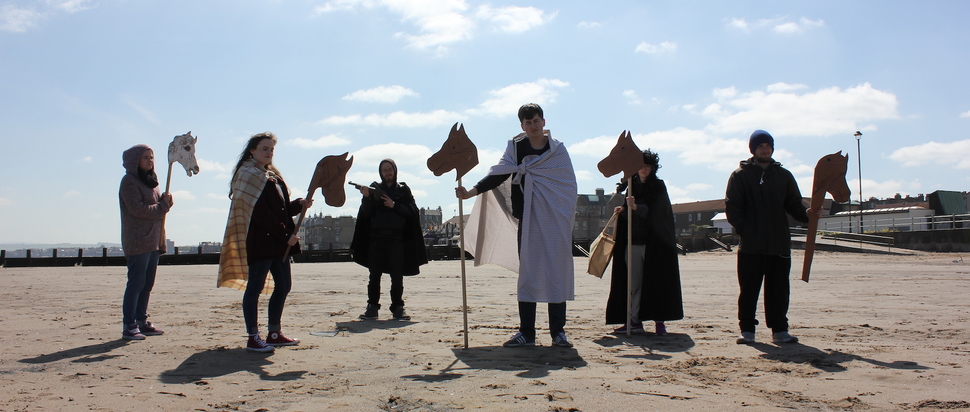Ruined: Dissecting the National Galleries of Scotland archives
Showcasing four years worth of young people experimenting and pulling apart the collections of the National Galleries of Scotland, the exhibition Ruined: Reinventing Scottish History comes from the work of the Image Liberation Force project
For four years, young people have been putting their own spin on Scottish history, using the National Galleries of Scotland as a jumping-off point. The changing group came together once a week as the Image Liberation Force, swapping in and out as they went into employment or aged out. Now in the Scottish National Portrait Gallery, their work’s been brought together for the first time in the exhibition Ruined: Reinventing Scottish History.
Facilitating this outreach work for the last 20 years, Senior Outreach Officer Robin Baillie leads efforts in trying to change the habits of Scotland’s major national galleries in attracting the interest of audiences beyond their usual Edinburgh middle and upper class base. But it’s been a long battle.
“We were given a corridor, then we made it into a gallery. Still, we matched what the rest of the National Galleries were doing, so we were given a bigger space, and we were generating really positive feedback. Higher up, they started to get it and realise that we need these audiences in.”
Week on week, the outreach programme would open out the National Galleries and its collections to young people on employability programmes in nearby areas. “There’s not much around for these young people. They’re burdened with the poverty they’ve experienced, along with a lack of support or encouragement around them.” Baillie also talks about many of them coming along have had “negative experiences of school and the law”.
When the young people came together to meet, the vibe was anarchic. “I want that and encourage that. It changes the balance of power.” For Baillie, there’s a playful atmosphere. “That’s democratic. No one can play better than anyone else.”
But play doesn’t mean that there wasn’t room for addressing heavier themes and topics. And this is reflected in the exhibition itself. “You’ve got to be really sensitive about the stories that they tell, these are real things. The feedback we’ve got from [the young people] is that they want to use the creative experience to cope with serious issues they’re all facing.”
A few years ago, one of the groups in the Borders went to Dryburgh Abbey. “I had a job lot of hessian sacks from B&Q, so they wore them as costumes and made up their own weird rituals. They spotted this conformity in the history there that reminded them of what they were living under as young people. In one of the films in the exhibition called The Sackening, they made drawings of the sack figure they made up."
Some of these showed hanging and suicide. The sensitivity of the subject matter started a conversation with the young people about whether it was right to publicise this kind of imagery widely. “I asked them: 'Do we put this in the exhibition?' And they were clear that it’s already out there. It’s in young people’s lives and they want to raise awareness that it’s something they’re struggling with. They know people that are in these situations.”
One of the biggest turning points of the project in the last few months came with the arrival of a new collaborator, Matt Tulloch, also known as Mercurius. Over the last six months, the young people worked closely with Mercurius, cutting together short videos of the work they’d made responding to the National Galleries’ collections. In turn, Mercurius would add in his own lyrics and music over the top.
“We’re getting better and working with the real voice of the young folk. Matt’s voice on top is their banner carrier, their herald, because he’s talented in his ability to make language gripping and on the point. He’s thrown up a lot of his own images as well.” For Bailie, Mercurius' voice is one that hasn’t been heard in the National Galleries, particularly as a representative of a fiercely intelligent and poetically talented working-class identity.
For Baillie, the secret is giving the work made by the young people the same level of care and consideration in showing it as would be given to “artist accredited art”. One example of this is the professional mixing and mastering of Mercurius’ music, or having the videos edited to industry standards. “You can’t match the authenticity of the images the young people make. They can produce better work than contemporary art. We never ask them just to copy an artist that’s already out there, they go beyond that.
“I would hope that nobody who sees this stuff can dismiss it. Even if they don’t like it, it’s coming straight at you. It’s about now and it’s about wanting something done. These young people have made this work. The politicians out there should be made to look at it. If they’re out there saying they want to hear young people’s voices, they need to make sure they know how to find it.”
Ruined: Reinventing Scottish History, Scottish National Portrait Gallery, until 14 Nov, Thu-Sat, 10am-5pm, free, booking required
nationalgalleries.org/exhibition/ruined-reinventing-scottish-history
